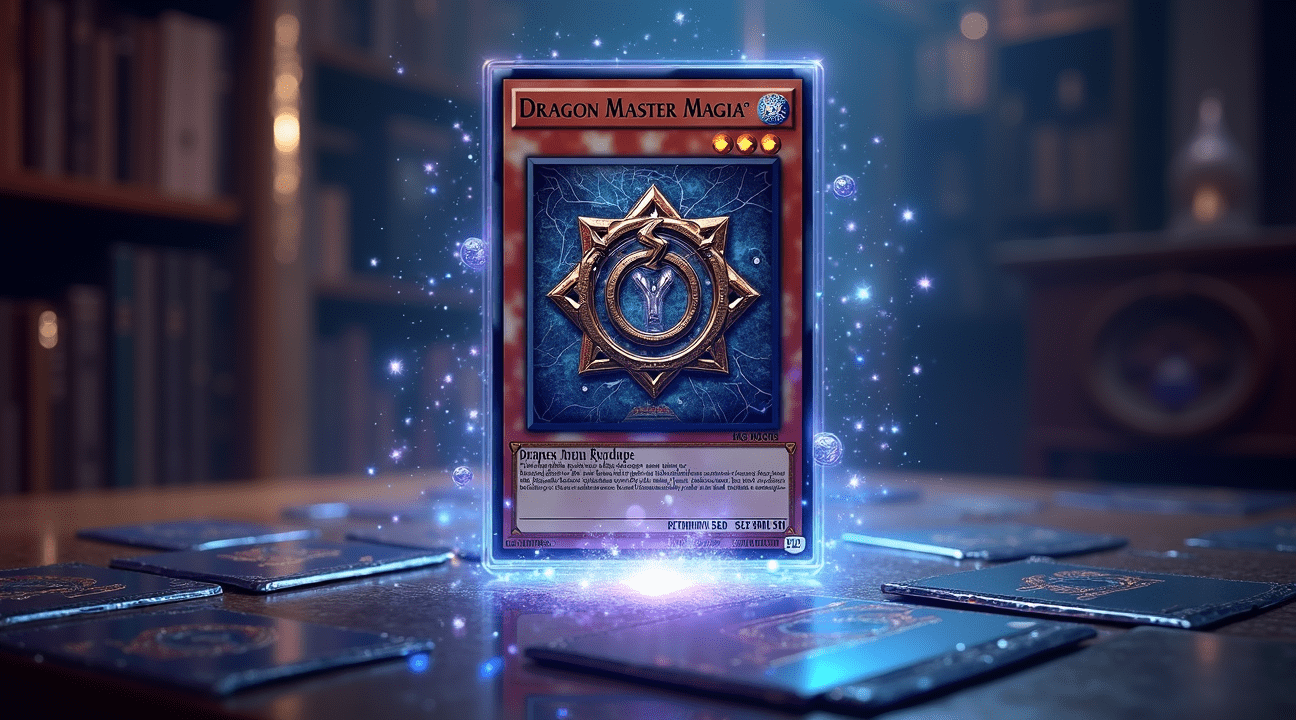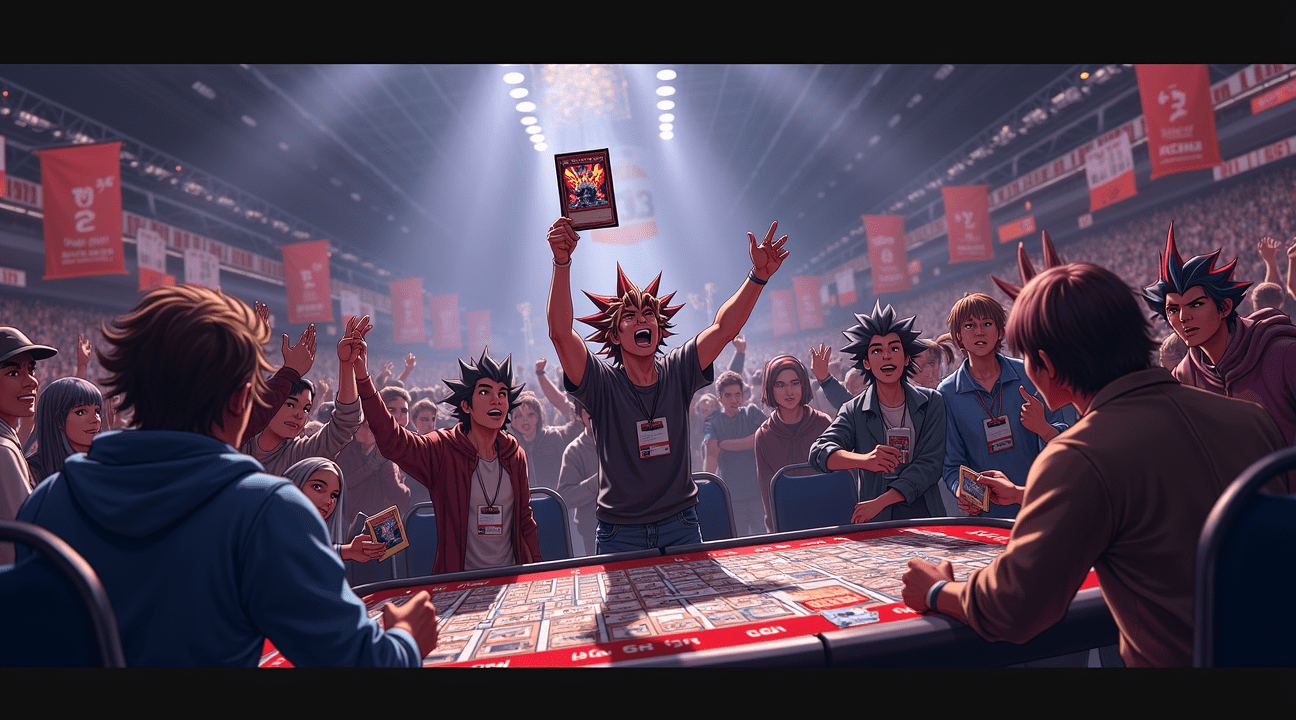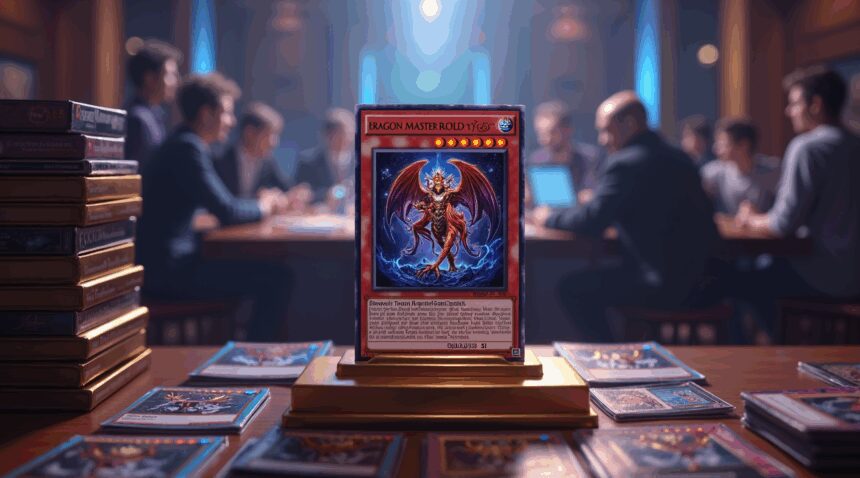Dragon Master Magia’s record-breaking $953.48 price tag demonstrates how premium rarities and strategic reprints have transformed Yu-Gi-Oh’s market landscape.
Key Takeaways
- Premium rarities like Quarter Century Secret Rare have created a new tier of ultra-expensive collectibles, with Dragon Master Magia’s $953.48 price demonstrating collector willingness to pay extreme premiums for guaranteed scarcity.
- Vintage cards maintain their value despite modern reprints because collectors prioritize authenticity, nostalgia, and historical significance over functional improvements found in updated versions.
- Strategic reprint sets successfully democratize competitive play by making tournament staples affordable, though oversaturation risks creating confusion and devaluing investments when releases come too frequently.
- Classic card revivals generate unexpected market ripples, where reprinted engines become accessible but their supporting cards experience dramatic price spikes as newly viable strategies emerge.
- Market saturation from excessive reprinting creates collector fatigue and forces Konami to balance accessibility for players against maintaining exclusivity that preserves long-term investment appeal.
As the Yu-Gi-Oh market continues to evolve, players and collectors alike must navigate the trade-offs between accessibility and rarity. For more insights, explore the official Yu-Gi-Oh site which offers updates on set releases and card values.
How Dragon Master Magia’s $953.48 Quarter Century Secret Rare Price Tag Reflects Yu-Gi-Oh’s Premium Market Evolution
The Yu-Gi-Oh trading card market has witnessed a dramatic transformation, with Dragon Master Magia’s staggering $953.48 price point serving as the perfect example of this evolution. I’ve observed how this particular card exists exclusively as a Quarter Century Secret Rare, making it one of the most coveted pieces in modern collecting circles as of April 2025.
This astronomical pricing doesn’t happen by accident. Dragon Master Magia currently holds the distinction of being the most expensive modern Yu-Gi-Oh card, a position that speaks volumes about collector behavior and market dynamics. The exclusive Quarter Century Secret Rare treatment has created what I consider a perfect storm of scarcity and desirability.
Premium Rarities Driving Market Revolution
The introduction of enhanced rarity tiers has fundamentally changed how collectors and players approach the secondary market. Quarter Century Secret Rare editions, along with upgraded Ultra Rares, represent Konami’s strategic response to growing demand for premium collectibles. These special treatments breathe new life into both classic cards and new releases, creating multiple value tiers within single card designs.
I’ve noticed several key factors that contribute to these market spikes:
- Limited print runs that guarantee scarcity from day one
- Enhanced visual appeal through foiling techniques and special artwork treatments
- Nostalgia-driven demand as collectors seek premium versions of beloved cards
- Investment potential that attracts both players and pure collectors
- Exclusivity appeal that makes ownership a status symbol within the community
The ripple effects of this premium strategy extend beyond individual cards. When Dragon Master Magia commands nearly $1,000, it validates the entire premium rarity concept and encourages further investment in similar products. Lower rarity versions of cards often see their values diminish as collectors gravitate toward these exclusive editions, creating a clear hierarchy in the marketplace.
This trend reflects broader changes in the Yu-Gi-Oh TCG landscape, where premium products increasingly drive revenue and community engagement. The success of cards like Dragon Master Magia demonstrates how strategic rarity management can maintain excitement and value in a mature trading card game.
Collector demand for exclusivity has reached unprecedented levels, with many viewing these premium cards as investment vehicles rather than purely gaming accessories. The Quarter Century Secret Rare designation has become synonymous with prestige, and Dragon Master Magia’s price tag proves that collectors will pay substantial premiums for guaranteed rarity and visual appeal.
The market’s strong preference for limited, high-rarity prints extends beyond competitive viability. Dragon Master Magia’s success stems from its perfect combination of scarcity, aesthetic appeal, and the psychological satisfaction of owning something truly exclusive. This psychological component can’t be understated – collectors often derive as much value from ownership prestige as they do from actual card utility.
Premium appeal has become a driving force in product development, with Konami clearly recognizing that strategic scarcity creates more sustainable value than mass production. The Quarter Century Secret Rare format represents a calculated approach to maintaining long-term collector interest while generating immediate revenue through high-value single sales.
These upgraded rarities have revitalized interest in cards that might otherwise have been overlooked, proving that presentation and scarcity can be just as important as gameplay mechanics in determining market success. Dragon Master Magia’s price trajectory serves as a blueprint for future premium releases, establishing that collectors will consistently pay top dollar for truly exclusive products that combine visual excellence with guaranteed rarity.

Why Vintage Cards Still Command Top Dollar While Modern Reprints Dominate Tournament Play
Nostalgia drives collectors to pay astronomical prices for vintage Yu-Gi-Oh cards, even when modern reprints offer superior tournament playability. I’ve observed firsthand how pristine original prints from the game’s early years maintain their value despite countless reprints flooding the market. A prime example involves the 2002 first-edition Summoned Skull, which commanded an impressive $2,640 in PSA 10 condition, demonstrating the incredible premiums collectors willingly pay for authentic vintage pieces.
Modern reprints excel at making powerful cards accessible to competitive players, but they can’t replicate the emotional connection collectors feel toward original releases. Yu-Gi-Oh’s changing landscape has created a fascinating dual market where tournament players gravitate toward affordable reprints while collectors chase after mint-condition originals.
The Collector Market Versus Tournament Accessibility
Several factors explain why vintage cards maintain their premium value despite functional reprints:
- Rarity creates exclusivity that reprints can’t match
- Original artwork and printing techniques hold historical significance
- PSA grading systems authenticate and preserve condition
- Childhood nostalgia drives adult collectors to recapture youth
- Investment potential attracts serious collectors seeking appreciation
Tournament players benefit enormously from reprints because they provide access to essential cards without breaking budgets. Upgraded versions often improve upon originals with better artwork, clearer text, or enhanced card stock, making them superior for actual gameplay. However, these improvements don’t translate to collector value since authenticity and historical significance matter more than functional enhancements.
The collector market operates on entirely different principles than the competitive scene. Collectors value provenance, condition, and emotional attachment over practical utility. They’re willing to pay thousands for cards they’ll never play because ownership connects them to specific memories or represents achievement within collecting circles.
Smart reprinting strategies actually protect vintage card values by creating clear distinctions between original and reprint versions. When Konami releases upgraded versions with different artwork or borders, they avoid flooding the market with identical copies that might devalue originals. This approach satisfies both segments without cannibalizing the collector market that drives significant revenue.
Professional grading services like PSA have revolutionized vintage card valuation by providing objective condition assessments. A PSA 10 rating guarantees museum-quality preservation, justifying extreme premiums that raw cards can’t achieve. This grading system creates clear hierarchies within the vintage market, allowing collectors to make informed purchasing decisions based on verified conditions.
Tournament accessibility through reprints ensures the game’s continued growth while preserving the investment potential of original cards. This delicate balance keeps Yu-Gi-Oh thriving across multiple markets simultaneously.
Reprint Sets Breaking Down Price Barriers for Competitive Duelists
Reprint sets serve as the great equalizer in Yu-Gi-Oh’s competitive landscape, transforming expensive staples into affordable options for players at every level. I’ve witnessed how these strategic releases democratize tournament play by putting powerful cards within reach of budget-conscious duelists who might otherwise be priced out of top-tier competition.
Market Accessibility Through Strategic Reprints
The secondary market’s relentless price increases create significant barriers for new and returning players. When a single playset of essential cards costs hundreds of dollars, competitive play becomes an exclusive club rather than an inclusive game. Reprint sets directly address this challenge by flooding the market with fresh copies of high-demand staples, forcing prices down across the board.
Recent products have demonstrated this principle effectively. The 2025 tins featured highly sought-after cards as Quarter Century Secret Rares, providing premium alternatives while simultaneously increasing overall supply. This approach satisfies collectors seeking rare treatments while ensuring competitive players can access the cards they need at reasonable prices.
Battles of Legend: Terminal Revenge exemplifies how targeted reprints can reshape entire format dynamics. By including tournament staples alongside fan-favorite cards, these sets ensure that competitive viability isn’t locked behind prohibitive price walls. I’ve seen countless players finally able to complete their decks after waiting months or years for affordable reprints.
The Double-Edged Nature of Frequent Releases
While reprints solve accessibility problems, they can create new challenges for the market ecosystem. Oversaturation becomes a real concern when multiple reprint products hit shelves in quick succession, leaving retailers with excess inventory and players confused about which versions retain long-term value.
Value dilution affects different card treatments differently. Original printings often maintain premium status among collectors, while mass-market reprints serve competitive players. However, when reprint frequency exceeds demand, even competitive players may delay purchases, anticipating better deals or more convenient releases.
The timing and selection of reprinted cards requires careful consideration:
- Cards reprinted too soon after their initial release risk alienating early investors.
- Cards held back too long can stagnate metas by gatekeeping viable strategies behind price walls.
Konami’s approach to reprint timing has evolved significantly as Yu-Gi-Oh’s landscape continues changing. Modern reprint philosophy balances market health with player accessibility, though finding the perfect equilibrium remains an ongoing challenge.
Tin series represent one of the most successful reprint formats because they combine accessibility with collectibility. These annual releases create predictable windows for reprints while maintaining excitement through exclusive treatments and new artwork. Players can budget for these releases, knowing that expensive cards will eventually receive more affordable versions.
The psychological impact of reprint announcements cannot be understated. Smart players monitor reprint schedules to time their purchases, while collectors may rush to secure original printings before values potentially decline. This dynamic creates interesting market movements that extend far beyond the actual release dates.
Newer players particularly benefit from reprint culture because it reduces the intimidation factor of entering competitive play. Instead of requiring massive upfront investments, players can gradually build competitive decks as reprints make individual components more affordable. This accessibility helps maintain healthy player populations across all skill levels.
Product differentiation helps minimize negative effects of frequent reprints. When publishers offer cards in multiple rarities or with distinct artwork, they create separate market segments that can coexist without completely cannibalizing each other’s value:
- Premium collectors get exclusive versions.
- Competitive players access functional copies at reasonable prices.
The strategic timing of reprint announcements also influences competitive formats. Players may avoid investing in expensive cards if reprints seem imminent, temporarily reducing format diversity until the reprints actually arrive. Conversely, surprise reprints can instantly shake up established metagames by making previously expensive strategies suddenly viable for broader player bases.

How Classic Card Revivals Shape Tournament Meta and Drive Unexpected Price Spikes
Classic card reprints create seismic shifts across competitive Yu-Gi-Oh!, transforming both tournament landscapes and card market dynamics in ways that surprise even veteran players. When Konami brings beloved vintage cards back with updated effects or premium rarities, these revivals don’t just offer nostalgic value—they fundamentally alter how decks function and compete at the highest levels.
Card engine reprints serve as the catalyst for these transformations. I’ve observed how a single reprinted combo piece can unlock entirely new strategies that were previously too expensive or simply unavailable to most players. The accessibility factor becomes crucial here, as tournament participants who couldn’t afford original printings suddenly gain access to powerful tools that reshape their deck-building options.
The Ripple Effect of Strategic Reprints
The market responds to reprints in predictable yet fascinating patterns. While the reprinted card’s price typically drops significantly, the supporting cards that complement newly accessible strategies experience dramatic price increases. This creates a ripple effect throughout the secondary market that experienced collectors and competitive players learn to anticipate and navigate strategically.
Tournament schedules amplify these effects considerably. Major events create concentrated demand periods where specific archetypes gain prominence, and Yu-Gi-Oh TCG changing landscapes become most apparent during these high-stakes competitions. Players scramble to acquire support cards for newly viable strategies, driving prices upward for anything that wasn’t included in recent reprints.
Meta shifts occur organically as reprints democratize access to previously elite strategies. Budget-conscious players can finally experiment with combo engines they’d only watched from sidelines, while established competitors must adapt their approaches to account for increased prevalence of formerly rare tactics. This creates a more diverse competitive environment where innovation flourishes alongside nostalgia.
The timing of reprints reveals Konami’s strategic understanding of market dynamics and player psychology. Release patterns often coincide with major tournament cycles, creating maximum impact on competitive play while satisfying collector demand for premium treatments of classic cards. These decisions recognize that modern players crave connections to the game’s rich history while demanding competitive viability in contemporary formats.
Nostalgia plays an undeniable role in driving interest beyond mere competitive utility. Players who started during earlier eras feel genuine excitement about revisiting strategies from their formative gaming experiences, now enhanced with modern card design principles. This emotional connection translates into sustained market activity that extends well beyond initial reprint announcements.
Price volatility becomes most pronounced around support cards that complement reprinted engines but remain scarce in the marketplace. Smart investors and competitive players monitor reprint announcements carefully, identifying which overlooked cards might suddenly become essential components of newly accessible strategies. These secondary market movements often exceed the impact of the original reprints themselves.
Tournament access improves dramatically when formerly expensive cards receive affordable reprints, leveling the playing field between different economic brackets of players. Regional and national events see increased diversity in deck choices as more participants can afford to experiment with previously prohibitive strategies, leading to more unpredictable and exciting competitive environments.
The pattern continues evolving as Konami learns from each reprint cycle’s reception and market impact. Recent years have shown increasingly sophisticated approaches to balancing nostalgia, competitive needs, and market stability through carefully planned reprint programs that consider both immediate tournament effects and long-term collection value.
Understanding these dynamics helps both competitive players and collectors make informed decisions about when to acquire cards, which strategies to pursue, and how market forces might affect their planned purchases. The interconnected nature of reprints, tournament meta, and price movements creates opportunities for those who recognize these patterns while maintaining the game’s accessibility and competitive integrity.
The Double-Edged Sword of Market Saturation in Modern Yu-Gi-Oh
I’ve observed a growing tension in the Yu-Gi-Oh community as Konami floods the market with countless reprint sets. Players appreciate the accessibility these reprints provide, but collectors face diminishing returns on their investments. The once-clear distinction between valuable cards and common staples has blurred significantly, creating confusion that affects both casual buyers and serious investors.
The Reprint Fatigue Phenomenon
Multiple versions of popular cards now exist across different rarities and sets, making price tracking a complex endeavor. I notice players struggling to determine which printing offers the best value, while collectors watch their premium cards lose exclusivity. This reprint fatigue has created market instability that wasn’t present during Yu-Gi-Oh’s earlier eras.
The situation becomes particularly problematic when analyzing collector demand patterns. High-value cards that once commanded premium prices suddenly appear in budget-friendly reprint sets, sometimes within months of their initial release. This rapid devaluation cycle discourages long-term collecting and investment, potentially undermining the game’s economic foundation.
Balancing Accessibility with Exclusivity
Konami faces mounting pressure from competing games that offer different approaches to card distribution. Magic: The Gathering and Pokémon have established successful models that maintain collector interest while ensuring competitive accessibility. Yu-Gi-Oh must adapt its strategy to remain competitive in this landscape.
The challenge extends beyond simple reprinting decisions. I see several critical factors that require careful management:
- Timing intervals between original releases and reprints need strategic planning
- Rarity distribution must preserve some exclusive elements for collectors
- Price points should make competitive play accessible without destroying secondary market value
- New product lines should complement rather than cannibalize existing offerings
Market saturation affects different player segments differently. Competitive players benefit from affordable access to tournament staples, while collectors feel frustrated by the constant devaluation of their investments. Yu-Gi-Oh’s evolving landscape reflects these competing interests as the game adapts to modern market demands.
The oversaturation issue also impacts local game stores, which struggle to maintain inventory value when reprint announcements can instantly crash card prices. Store owners must now factor reprint risks into their purchasing decisions, often leading to more conservative buying patterns that can limit product availability.
Finding the optimal balance requires understanding that accessibility and exclusivity aren’t mutually exclusive concepts. Successful implementation involves creating distinct product tiers that serve different market segments without undermining each other’s value propositions.

Sources:
TCGPlayer Seller Blog: “Price Trends: Yu-Gi-Oh! Cards Climbing in Price – 04/01/2025”
YouTube (Team APS): “I’m Noticing 3 Weird Yu-Gi-Oh Trends”
YouTube: “What YuGiOh NEEDS in 2025…”
YouTube (MST.TV): “Tin Reprints & Future Meta Trends Causing Massive Buyouts! Yu-Gi…”
YouTube: “Huge Changes Send Shockwaves Through the Market! Yu…”
Vaulted Collection: “Top 30 Most Expensive Yu-Gi-Oh! Cards”


